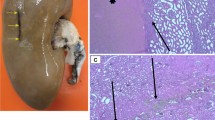Abstract
The objective is to evaluate the histological damage to the ureteral wall caused by the prolonged placement of an access sheath in porcine model. Six ureters from three female pigs were randomized into three groups. In each group, an UAS with different indwelling time was inserted. 9.5/11.5 Fr Flexor® ureteral access sheaths were inserted in both ureters with left indwelling for 30 min and right for 60 min. The ureteral access sheath was advanced up to the proximal ureter. No resistance was observed during the insertion. Ureters were harvested in immediately after the sheath placement process in one pig. The ureters of the remaining two pigs were removed at 1 and 2 weeks after the procedure, respectively. Histological examination took place also in these specimens. Ureters with an indwelling time of 30 min: histological examination of the ureter after immediate dissection revealed signs of acute inflammation at the distal ureter. The ureter dissected at 1 week showed minimal focal transmural inflammation along its length with minimal epithelial hyperplasia. The ureter dissected at 2 weeks, no signs of inflammation. Ureters with an indwelling time of 60 min: histological examination of the immediately dissected ureter revealed signs of acute inflammation at the distal ureter. At 1 week, chronic transmural inflammation was predominantly observed in the distal ureter. At 2 weeks, minimal transmural inflammation was observed. The use of UAS did not cause any severe histological damage on porcine ureters. Acute signs of inflammation gradually recovered within 2 weeks.






Similar content being viewed by others
References
Abrahams HM, Stoller ML (2004) The argument against the routine use of ureteral access sheaths. Urol Clin N Am 31:83–87
Al-Qahtani SM, Letendre J, Thomas A, Natalin R, Saussez T, Traxer O (2014) Which ureteral access sheath is compatible with your flexible ureteroscope? J Endourol Endourol Soc 28:286–290
Delvecchio FC, Auge BK, Brizuela RM, Weizer AZ, Silverstein AD, Lallas CD, Pietrow PK, Albala DM, Preminger GM (2003) Assessment of stricture formation with the ureteral access sheath. Urology 61:518–522 (discussion 522)
Emre Sener T, Cloutier J, Villa L, Marson F, Buttice S, Doizi S, Traxer O (2016) Can we provide low intrarenal pressures with good irrigation flow by decreasing the size of ureteral access sheaths? J Endourol Endourol Soc 30:49–55
Kaplan AG, Lipkin ME, Scales CD, Jr., Preminger GM (2016) Use of ureteral access sheaths in ureteroscopy. Nat Rev Urol 13(3):135–140
Lallas CD, Auge BK, Raj GV, Santa-Cruz R, Madden JF, Preminger GM (2002) Laser Doppler flowmetric determination of ureteral blood flow after ureteral access sheath placement. J Endourol Endourol Soc 16:583–590
Nakada SY, Soble JJ, Gardner SM, Wolf JS Jr, Figenshau RS, Pearle MS, Humphrey PA, Clayman RV (1996) Comparison of acucise endopyelotomy and endoballoon rupture for management of secondary proximal ureteral stricture in the porcine model. J Endourol Endourol Soc 10:311–318
Pedro RN, Weiland D, Reardon S, Monga M (2007) Ureteral access sheath insertion forces: implications for design and training. Urol Res 35:107–109
Schoenthaler M, Buchholz N, Farin E, Ather H, Bach C, Bach T, Denstedt JD, Fritsche HM, Grasso M, Hakenberg OW, Herwig R, Knoll T, Kuehhas FE, Liatsikos E, Liske P, Marberger M, Osther PJ, Santos JM, Sarica K, Seitz C, Straub M, Traxer O, Trinchieri A, Turney B, Miernik A (2014) The Post-Ureteroscopic Lesion Scale (PULS): a multicenter video-based evaluation of inter-rater reliability. World J Urol 32:1033–1040
Stern JM, Yiee J, Park S (2007) Safety and efficacy of ureteral access sheaths. J Endourol Endourol Soc 21:119–123
Traxer O, Thomas A (2013) Prospective evaluation and classification of ureteral wall injuries resulting from insertion of a ureteral access sheath during retrograde intrarenal surgery. J Urol 189:580–584
Traxer O, Wendt-Nordahl G, Sodha H, Rassweiler J, Meretyk S, Tefekli A, Coz F, de la Rosette JJ (2015) Differences in renal stone treatment and outcomes for patients treated either with or without the support of a ureteral access sheath: the Clinical Research Office of the Endourological Society Ureteroscopy Global Study. World J Urol 33:2137–2144
Türk C, Petřík A, Sarica K, Seitz C, Skolarikos A, Straub M, Knoll T (2016) EAU guidelines on interventional treatment for urolithiasis. Eur Urol 69(3):475–482
Author information
Authors and Affiliations
Corresponding author
Ethics declarations
Conflict of interest
None of the authors has any conflict of interest.
Funding
No funding was received for this study.
Ethical approval
All applicable international, national, and/or institutional guidelines for the care and use of animals were followed.
Rights and permissions
About this article
Cite this article
Özsoy, M., Kyriazis, I., Vrettos, T. et al. Histological changes caused by the prolonged placement of ureteral access sheaths: an experimental study in porcine model. Urolithiasis 46, 397–404 (2018). https://doi.org/10.1007/s00240-017-1007-9
Received:
Accepted:
Published:
Issue Date:
DOI: https://doi.org/10.1007/s00240-017-1007-9




